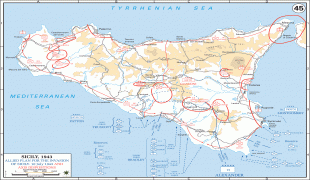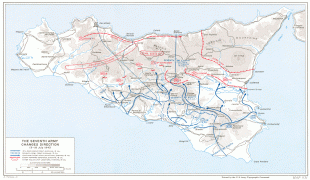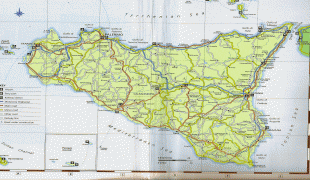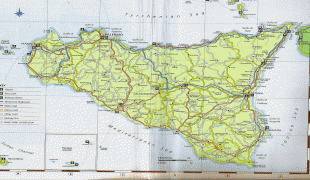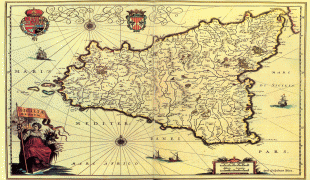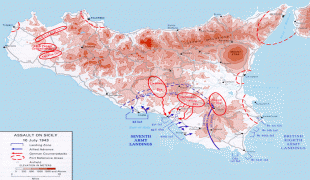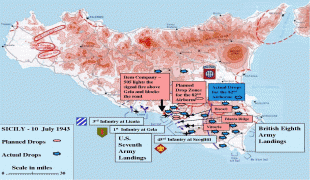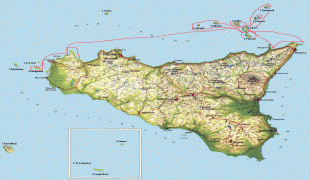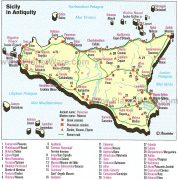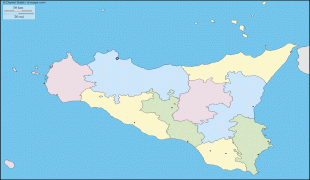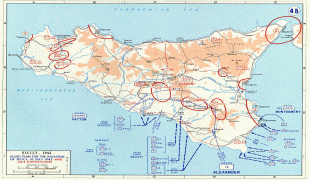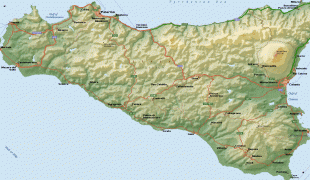Sicily (Sicilia)
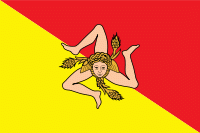 |
 |
Sicily is in the central Mediterranean Sea, south of the Italian Peninsula in continental Europe, from which it is separated by the narrow Strait of Messina. Its most prominent landmark is Mount Etna, the tallest active volcano in Europe, and one of the most active in the world, currently 3357 m high. The island has a typical Mediterranean climate.
The earliest archaeological evidence of human activity on the island dates from as early as 12,000 BC. By around 750 BC, Sicily had three Phoenician and a dozen Greek colonies and it was later the site of the Sicilian Wars and the Punic Wars. After the end of the Roman province of Sicilia with the fall of the Roman Empire in the 5th century AD, Sicily was ruled during the Early Middle Ages by the Vandals, the Ostrogoths, the Byzantine Empire, and the Emirate of Sicily. The Norman conquest of southern Italy led to the creation of the County of Sicily in 1071, that was succeeded by Kingdom of Sicily, a state that existed from 1130 until 1816. Later, it was unified under the House of Bourbon with the Kingdom of Naples as the Kingdom of the Two Sicilies. The island became part of Italy in 1860 following the Expedition of the Thousand, a revolt led by Giuseppe Garibaldi during the Italian unification, and a plebiscite. Sicily was given special status as an autonomous region on 15 May 1946, 18 days before the Italian institutional referendum of 1946.
Sicily has a rich and unique culture, especially with regard to the arts, music, literature, cuisine, and architecture.
Sicily has a roughly triangular shape, earning it the name Trinacria.
To the north-east, it is separated from Calabria and the rest of the Italian mainland by the Strait of Messina, about 3 km wide in the north, and about 16 km wide in the southern part. The northern and southern coasts are each about 280 km long measured as a straight line, while the eastern coast measures around 180 km; total coast length is estimated at 1484 km. The total area of the island is 25711 km2, while the Autonomous Region of Sicily (which includes smaller surrounding islands) has an area of 27708 km2.
The terrain of inland Sicily is mostly hilly and is intensively cultivated wherever possible. Along the northern coast, the mountain ranges of Madonie, 2000 m, Nebrodi, 1800 m, and Peloritani, 1300 m, are an extension of the mainland Apennines. The cone of Mount Etna dominates the eastern coast. In the southeast lie the lower Hyblaean Mountains, 1000 m. The mines of the Enna and Caltanissetta districts were part of a leading sulphur-producing area throughout the 19th century, but have declined since the 1950s.
Sicily and its surrounding small islands have some highly active volcanoes. This is due to the fact Sicily is geographically on the northern edge of the African continental plate. Mount Etna is the largest active volcano in Europe and casts black ash over the island with its recurrent eruptions. It currently stands 3329 m high, though this varies with summit eruptions; the mountain is 21 m lower now than it was in 1981. It is the highest mountain in Italy south of the Alps. Etna covers an area of 1190 km2 with a basal circumference of 140 km. This makes it by far the largest of the three active volcanoes in Italy, being about two and a half times the height of the next largest, Mount Vesuvius. In Greek mythology, the deadly monster Typhon was trapped under the mountain by Zeus, the god of the sky. Mount Etna is widely regarded as a cultural symbol and icon of Sicily.
The Aeolian Islands in the Tyrrhenian Sea, to the northeast of mainland Sicily form a volcanic complex. The three volcanoes of Vulcano, Stromboli and Lipari are also currently active, although the latter is usually dormant. Off the southern coast of Sicily, the underwater volcano of Ferdinandea, which is part of the larger Empedocles volcano, last erupted in 1831. It is located between the coast of Agrigento and the island of Pantelleria (which itself is a dormant volcano).
From a geographical perspective, also forming a part of Sicily is the Maltese Archipelago, the islands home to the republic of Malta.
Map - Sicily (Sicilia)
Map
Country - Italy
 |
 |
| Flag of Italy | |
Italy was the native place of many civilizations such as the Italic peoples and the Etruscans, while due to its central geographic location in Southern Europe and the Mediterranean, the country has also historically been home to myriad peoples and cultures, who immigrated to the peninsula throughout history. The Latins, native of central Italy, formed the Roman Kingdom in the 8th century BC, which eventually became a republic with a government of the Senate and the People. The Roman Republic initially conquered and assimilated its neighbours on the Italian peninsula, eventually expanding and conquering a large part of Europe, North Africa and Western Asia. By the first century BC, the Roman Empire emerged as the dominant power in the Mediterranean Basin and became a leading cultural, political and religious centre, inaugurating the Pax Romana, a period of more than 200 years during which Italy's law, technology, economy, art, and literature developed.
Currency / Language
| ISO | Currency | Symbol | Significant figures |
|---|---|---|---|
| EUR | Euro | € | 2 |
| ISO | Language |
|---|---|
| CA | Catalan language |
| CO | Corsican language |
| FR | French language |
| DE | German language |
| IT | Italian language |
| SC | Sardinian language |
| SL | Slovene language |






